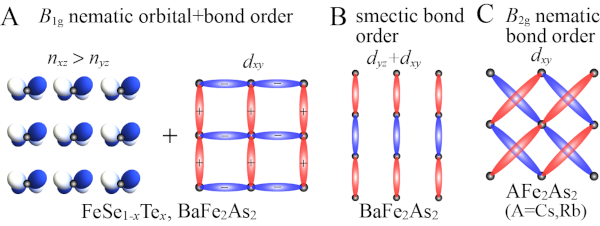Diverse Exotic Orders and Fermiology in Fe-Based Superconductors: A Unified Mechanism for B1g/B2g Nematicity in FeSe/(Cs,Rb)Fe2As2 and Smectic Order in BaFe2As2
S. Onari and H. Kontani, Front. Phys. 10, 915619 (2022).
A rich variety of nematic/smectic orders in Fe-based superconductors is an important unsolved problem in strongly correlated electron systems. A unified understanding of these orders has been investigated for the last decade. In this study, we explain the B1g symmetry nematic transition in FeSe1−xTex, the B2g symmetry nematicity in AFe2As2 (A = Cs, Rb), and the smectic state in BaFe2As2 based on the same framework. We investigate the quantum interference mechanism between spin fluctuations by developing the density wave equation. The observed rich variety of nematic/smectic orders is naturally understood in this mechanism. The nematic/smectic orders depend on the characteristic shape and topology of the Fermi surface (FS) of each compound. 1) In FeSe1−xTex (nd = 6.0), each FS is very small and the dxy-orbital hole pocket is below the Fermi level. In this case, the small spin fluctuations on three dxz, dyz, and dxy orbitals cooperatively lead to the B1g nematic (q = 0) order without magnetization. The experimental Lifshitz transition below the nematic transition temperature (TS) is naturally reproduced. 2) In BaFe2As2 (nd = 6.0), the dxy-orbital hole pocket emerges around the M point, and each FS is relatively large. The strong spin fluctuations due to the dxy-orbital nesting give rise to the B1g nematic (q = 0) order and the smectic [q = (0, π)] order, and the latter transition temperature (T* ∼ 170K) exceeds the former one (TS ∼ 140K). 3) In heavily hole-doped AFe2As2 (nd = 5.5), the large dxy-orbital hole pocket and the four tiny Dirac pockets appear due to the hole-doping. The B2g nematic bond order emerges on the dxy-orbital hole pocket because of the same interference mechanism. The present paramagnon interference mechanism provides a unified explanation of why the variety of nematic/smectic orders in Fe-based superconductors is so rich, based on the well-established fermiology of Fe-based superconductors.
(Click figure for a larger image.)

